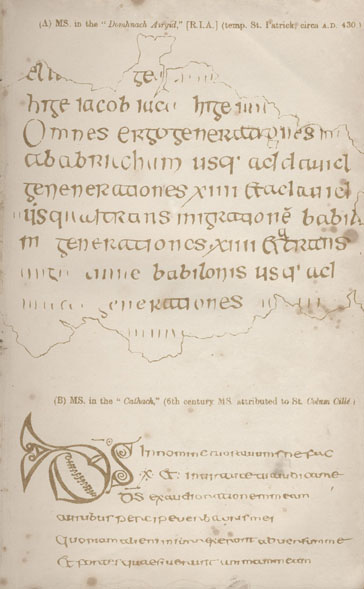Celtic Manuscripts
The principal Celtic MSS. which are still preserved to us, may be consulted in the Library of Trinity College, Dublin, and in the Library of the Royal Irish Academy. The latter, though founded at a much later period, is by far the more extensive, if not the more important, collection. Perhaps, few countries have been so happy as to possess a body of men so devoted to its archaeology, so ardent in their preservation of all that can be found to illustrate it, and so capable of elucidating its history by their erudition, which, severally and collectively, they have brought to bear on every department of its ethnology.

Manuscripts from the Domhnach Airgid and Cathach
The collection in Trinity College consists of more than 140 volumes, several of them are vellum,[3] dating from the early part of the twelfth to the middle of the last century. The collection of the Royal Irish Academy also contains several works written on vellum, with treatises of history, science, laws, and commerce; there are also many theological and ecclesiastical compositions, which have been pronounced by competent authorities to be written in the purest style that the ancient Gaedhilic language ever attained. There are also a considerable number of translations from Greek, Latin, and other languages. These are of considerable importance, as they enable the critical student of our language to determine the meaning of many obscure or obsolete words or phrases, by reference to the originals; nor are they of less value as indicating the high state of literary culture which prevailed in Ireland during the early Christian and the Middle Ages.
Poetry, mythology, history, and the classic literature of Greece and Rome, may be found amongst these translations; so that, as O'Curry well remarks, "any one well read in the comparatively few existing fragments of our Gaedhilic literature, and whose education had been confined solely to this source, would find that there are but very few, indeed, of the great events in the history of the world with which he was not acquainted."[4] He then mentions, by way of illustration of classical subjects, Celtic versions of the Argonautic Expedition, the Siege of Troy, the Life of Alexander the Great; and of such subjects as cannot be classed under this head, the Destruction of Jerusalem; the Wars of Charlemagne, including the History of Roland the Brave; the History of the Lombards, and the almost contemporary translation of the Travels of Marco Polo.
There is also a large collection of MSS. in the British Museum, a few volumes in the Bodleian Library at Oxford, besides the well-known, though inaccessible, Stowe collection.[5]
Notes
[3] Vellum.—The use of vellum is an indication that the MSS. must be of some antiquity. The word "paper" is derived from papyrus, the most ancient material for writing, if we except the rocks used for runes, or the wood for oghams. Papyrus, the pith of a reed, was used until the discovery of parchment, about 190 B.C. A MS. of the Antiquities of Josephus on papyrus, was among the treasures seized by Buonaparte in Italy.
[4] Acquainted.—O'Curry's MS. Materials, page 24.
[5] Collection.—A recent writer in the Cornhill says that Lord Ashburnham refuses access to this collection, now in his possession, fearing that its contents may be depreciated so as to lessen its value at a future sale. We should hope this statement can scarcely be accurate. Unhappily, it is at least certain that access to the MSS. is denied, from whatever motive.
